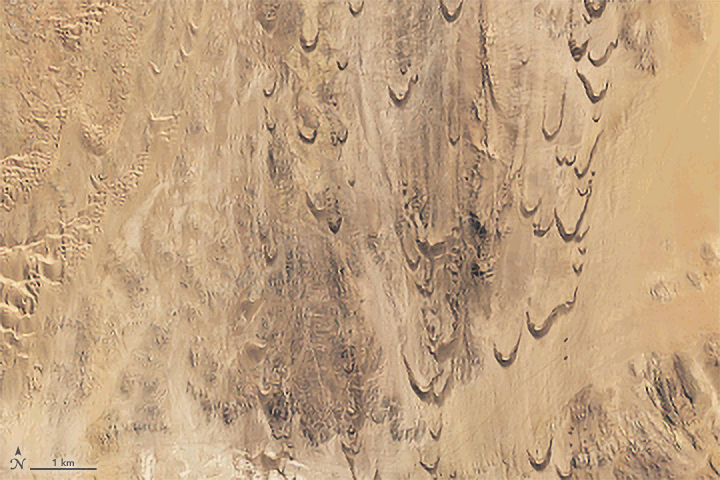Publié le 9 janvier 2023
The rapid movement of the dunes is clear in this series of Landsat 8 and 9 images acquired between 2013 and 2022 (one scene per year). The images show a group of crescent-shaped barchan dunes and more linear transverse dunes located in the Sperrgebiet region of the southern Namib desert. The dunes have migrated northward by several kilometers in recent decades, driven primarily by the region’s persistent south-southwest winds.
Researchers from the Desert Research Institute and the Smithsonian Institution used satellite observations from the Advanced Spaceborne Thermal Emission and Reflection Radiometer (ASTER) on NASA’s Terra satellite to study the motion of the dunes over an eight-year period and found that the average rate at which the dunes in this area moved ranged from 7 to 32 meters (23 to 105 feet) per year.

April 2013 - April 2022
Large dunes tended to preserve their shape, moving at an average of about 9 meters per year, according to the researchers. Some of the smaller dunes were much faster, with some moving as quickly as 83 meters (272 feet) per year. Unlike the larger dunes, the smaller dunes tended to appear and disappear. Tracking dunes with satellite images over years and decades reveals smaller dunes regularly popping up and passing larger crescent-shaped barchan dunes.
“This is a very high energy wind regime with strong southerly winds, especially in austral summer. It’s one of the windiest desert regions in the world,” said Nick Lancaster, a dune expert and emeritus research professor at the Desert Research Institute. “As a result, the Sperrgebiet dunes are among the fastest-moving dunes in the world.”
Source:
NASA. (2023, January 9). Racing Dunes in Namibia. Earth Observatory. Retrieved January 9, 2023